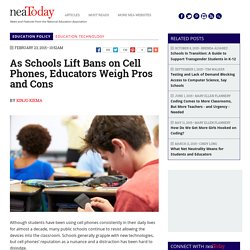

Should teachers be using social media in the classroom? Photo by David Paul Morris/Bloomberg via Getty Images Editor’s note: About once a month, the NewsHour’s editorial staff huddles in our conference room to brainstorm ideas for “theme weeks” where we explore a single topic from all different — and sometimes surprising — angles.

The idea for an off-the-grid week came up. Stories about energy, geography and even fine arts were pitched. We also talked about the social media “grid” and asked, how long do we keep our children off the grid and is there value in young people engaging with social tools from Instagram to iPad apps? For the latter we turned to two teachers who have competing views about allowing social media in their classrooms. Yes: Bring social media to all classrooms I have found the quietest students in my class speak the loudest on social media. One day, Nadia, a very quiet and reserved student, walked into class and said, “Mr. “What?” Cell Phones in School. As Schools Lift Bans on Cell Phones, Educators Weigh Pros and Cons. Although students have been using cell phones consistently in their daily lives for almost a decade, many public schools continue to resist allowing the devices into the classroom.

Schools generally grapple with new technologies, but cell phones’ reputation as a nuisance and a distraction has been hard to dislodge. Recently, however, the acceptance of these devices has been growing. Beginning in March, New York City, the largest school district in the country with 1.1 million students, will reverse its long standing ban on cell phones in schools. The ban, which was implemented by the Bloomberg administration, went into effect in 2006, but Mayor Bill De Blasio championed the policy change, saying that he thought it was important for parents to be able to easily contact their kids. Will more districts around the country follow? “First it was a very slow domino fall, and now we’re seeing more of a tidal wave,” Kolb explains. Should Schools Embrace “Bring Your Own Device”?
The news magazine for high school. Cell Phones at School: Should They Be Allowed? Highlights Eureka!

5 Easy STEM Activities to Try at Home Try these fun STEM activities for kids and make math and science their favorite subjects! Find Today's Newest & Best Children's Books Looking for newly released books for your child? Try our Book Finder tool to search for new books by age, type, and theme! Parents' Guide to Prom: 6 Must-Discuss Topics Prepare your teen for a safe night out with our prom discussion guide for parents. Cell Phones in the Classroom: Are we Dialing up Disaster?: EBSCOhost.
PIP%20Teens%20and%20Mobile%20Phones%20Data%20Memo.pdf. k0802zir.pdf. From Cell Phone Skeptic to Evangelist. Mobile Devices in the Classroom. As cell phones—with ever-expanding possibilities of texting, Web browsing, and game playing—have multiplied in recent years among teenagers and even preteens, so have the concerns of teachers and administrators about the distractions these devices can cause.

A survey of students and parents earlier this year by the group Common Sense Media found that almost 70 percent of schools around the country ban student cell phone use during the school day. But some districts and administrators are realizing the untapped potential of cell phones. It’s part of an “anytime, anywhere” learning movement that leaves laptops and even smaller netbooks behind, proponents say, in favor of more mobile, affordable and reliable handheld devices—from “smartphones,” which can run operating systems such as Windows Mobile and a host of software, to iPods, known more for playing audio and video but adaptable to more interactive applications through new educational platforms (see the sidebar on mobile devices). Is It Safe to Allow Cell Phones in School? Cell phones were banned from most schools years ago, but after the Columbine High School and 9/11 tragedies, parents started pressuring some school boards and administrators to reverse the bans.

On its surface, allowing students to have cell phones under the guise of improved school safety may seem like a “no-brainer” to many board members and administrators. But an in-depth analysis suggests that while students having cell phones may make parents feel better, it actually could create a less safe situation in a school crisis. The Discipline Challenges On a daily basis, cell phones pose a disruption to the educational environment. Students cannot fully benefit from classroom instruction if they are distracted by incoming text messages and vibrations from incoming calls. National School Debate: Banning Cell Phones in Public Schools: Analyzing a National School and Community Relations Problem, Online Submission, 2007-Jul-11. Cell Phones in American High Schools: A National Survey, Journal of Technology Studies, 2007. A survey instrument to determine school policy and practice regarding cell phone use by teachers and students was developed using a literature review, a panel of experts, and then a pilot study with typical respondents.

The survey was mailed out randomly to 200 high school principals representing all 50 states. The return rate was 56 percent with responses coming from all regions of the country.